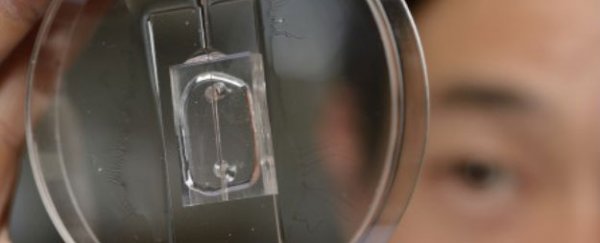A new device developed by a team from Johns Hopkins University in the US has allowed them to watch and record the behaviour of human breast cancer cells as they burrow through biological tissue, infiltrate blood vessels, and enter the blood stream to travel quickly and easily through the body.
This migration process is known as metastasis, and it allows cancer cells to spread from the organ they originated in, such as the breast, to an entirely different organ, such as the lungs. More than 90 percent of cancer-related deaths are caused by metastatic cancer cells spreading around the body, but until now, scientists haven't been able to get a good, clear look at this incredibly efficient and complex process.
"There's still so much we don't know about exactly how tumour cells migrate through the body, partly because, even using our best imaging technology, we haven't been able to see precisely how these individual cells move into blood vessels," said lead researcher and bioengineer, Andrew D. Wong, in a press release. "Our new tool gives us a clearer, close-up look at this process."
Publishing in the journal Cancer Research, the researchers describe how they arranged artificial biological tissue and artificial blood cells on a small transparent chip to test out their device. A special nutrient-rich solution was injected into the chip and made to flow through the artificial blood vessel just like a real bloodstream would. When they were ready to observe the process of metastasis, the researchers inserted individual and clustered human breast cancer cells into the artificial tissue to see what they did. The breast cancer cells were labelled with fluorescent tags so they could be easily tracked and recorded.
In their tests, the artificial tissue acted just like human tissue does in an actual cancer patient - it actively surrounded the tumour in an effort to contain it. The team watched as a number of cancer cells broke free from the tumour, and somehow managed to push their way through the surrounding tissue and move towards the artificial blood vessel.
Human blood vessels are contained by a barrier of endothelial cells, which are supposed to keep any nasties out, but cancer cells are often able to force their way in. Single cancer cells operating in the Johns Hopkins device were able to push their way through the endothelial layer and into an artificial blood vessel, effectively infiltrating the hypothetical bloodstream. In a real-life scenario, these cancer cells would now be free to hitch a ride to other places in the body and form new tumours.
"Cancer cells would have a tough time leaving the original tumour site if it weren't for their ability to enter our bloodstream and gain access to distant sites," said Wong. "So it's actually the entry of cancer cells into the bloodstream that allows the cancer to spread very quickly."
The device offered such a detailed view, Wong's team was able to observe a single cancer cell as it located a weak spot in the lining of the blood vessel, exerted enough pressure on it to break through, and then squeezed itself in far enough to be taken up by the bloodstream. According to the researchers, until now, it's been virtually impossible to see these crucial steps in cancer migration with such clarity.
Other than the incredibly detailed view this device offers, another advantage is that the cancer migration process can be viewed countless times without invasive procedures being carried out on actual cancer patients. The team now plans to test a number of cancer-fighting drugs out on the device to see how they affect the movement of cancer cells, and how they can be improved.
"This device allows us to look at the major steps of metastasis as well as to test different treatment strategies at a relatively fast pace," said Wong. "If we can find a way to stop one of these steps in the metastatic cascade, we may be able to find a new strategy to slow down or even stop the spread of cancer."
Click here to watch some captured footage of a cancer cell approach the team's artificial blood vessel and force its way through into the hypothetical bloodstream.
